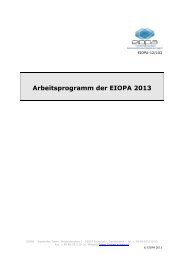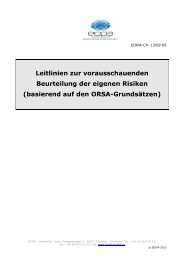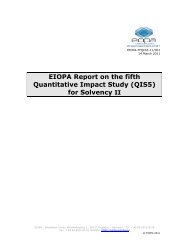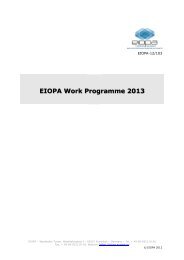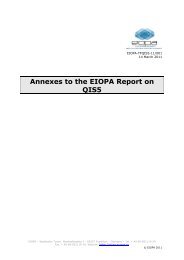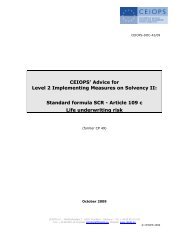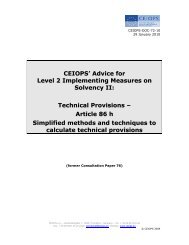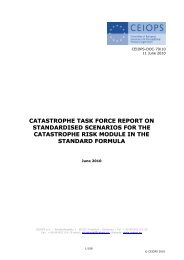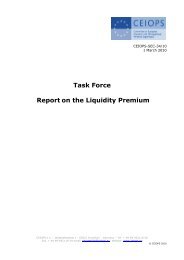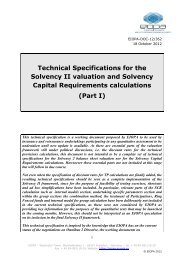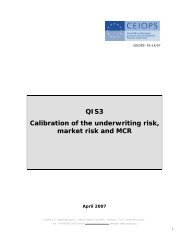Answers to the European Commission on the ... - Eiopa - Europa
Answers to the European Commission on the ... - Eiopa - Europa
Answers to the European Commission on the ... - Eiopa - Europa
You also want an ePaper? Increase the reach of your titles
YUMPU automatically turns print PDFs into web optimized ePapers that Google loves.
<strong>on</strong>e year). Therefore, capital requirements and amounts in technical<br />
provisi<strong>on</strong>s are not fully interchangeable.<br />
7.4 In its answer <str<strong>on</strong>g>to</str<strong>on</strong>g> CfA 10, CEIOPS takes <str<strong>on</strong>g>the</str<strong>on</strong>g> view that <str<strong>on</strong>g>the</str<strong>on</strong>g> solvency<br />
capital requirement (SCR) should limit <str<strong>on</strong>g>the</str<strong>on</strong>g> risk that <str<strong>on</strong>g>the</str<strong>on</strong>g> level of<br />
available capital deteriorates <str<strong>on</strong>g>to</str<strong>on</strong>g> an unacceptable level at any time<br />
during <str<strong>on</strong>g>the</str<strong>on</strong>g> specified time horiz<strong>on</strong>. The unacceptable level of capital is<br />
defined as <str<strong>on</strong>g>the</str<strong>on</strong>g> point where assets no l<strong>on</strong>ger exceed technical provisi<strong>on</strong>s<br />
(valued with a prudential risk margin, and compatible with <str<strong>on</strong>g>the</str<strong>on</strong>g><br />
principles laid out in CEIOPS’ answer <str<strong>on</strong>g>to</str<strong>on</strong>g> CfA’s 7 and 8) and o<str<strong>on</strong>g>the</str<strong>on</strong>g>r<br />
liabilities. This general c<strong>on</strong>cept ensures that <str<strong>on</strong>g>the</str<strong>on</strong>g> two main building<br />
blocks of <str<strong>on</strong>g>the</str<strong>on</strong>g> quantitative requirements under Solvency II - valuati<strong>on</strong><br />
of technical liabilities and determinati<strong>on</strong> of capital requirements – are<br />
part of a c<strong>on</strong>sistent overall framework. In a situati<strong>on</strong> where a certain<br />
type of risk (e.g., reserve risk in n<strong>on</strong>-life insurance) affects both <str<strong>on</strong>g>the</str<strong>on</strong>g><br />
prudential risk margin in <str<strong>on</strong>g>the</str<strong>on</strong>g> provisi<strong>on</strong>s and <str<strong>on</strong>g>the</str<strong>on</strong>g> capital requirement,<br />
<str<strong>on</strong>g>the</str<strong>on</strong>g> quantificati<strong>on</strong> of <str<strong>on</strong>g>the</str<strong>on</strong>g> capital requirement would take in<str<strong>on</strong>g>to</str<strong>on</strong>g> account<br />
<str<strong>on</strong>g>the</str<strong>on</strong>g> partial unwinding of <str<strong>on</strong>g>the</str<strong>on</strong>g> prudential risk margin over <str<strong>on</strong>g>the</str<strong>on</strong>g> specified<br />
time horiz<strong>on</strong>, thus avoiding a potental ‘double counting’ of risks.<br />
7.5 In setting an appropriate risk margin, CEIOPS recognises that <str<strong>on</strong>g>the</str<strong>on</strong>g>re are<br />
a number of issues that need <str<strong>on</strong>g>to</str<strong>on</strong>g> be c<strong>on</strong>sidered:<br />
• any risk premium necessary <str<strong>on</strong>g>to</str<strong>on</strong>g> ensure <str<strong>on</strong>g>the</str<strong>on</strong>g> transferabilty of <str<strong>on</strong>g>the</str<strong>on</strong>g><br />
liabilties <str<strong>on</strong>g>to</str<strong>on</strong>g> a third party<br />
• addressing uncertainty in <str<strong>on</strong>g>the</str<strong>on</strong>g> valuati<strong>on</strong> of <str<strong>on</strong>g>the</str<strong>on</strong>g> ‘best estimate’<br />
• achieving an appropriate level of policyholder protecti<strong>on</strong> over <str<strong>on</strong>g>the</str<strong>on</strong>g><br />
run-off period of <str<strong>on</strong>g>the</str<strong>on</strong>g> liabilities<br />
• supporting harm<strong>on</strong>isati<strong>on</strong> by setting a quantitative standard in an<br />
explicit manner<br />
7.6 CEIOPS is exploring which level of c<strong>on</strong>fidence can be used <str<strong>on</strong>g>to</str<strong>on</strong>g> meet<br />
<str<strong>on</strong>g>the</str<strong>on</strong>g>se c<strong>on</strong>siderati<strong>on</strong>s. Alternative formulati<strong>on</strong>s, such as a pure ‘market<br />
value margin approach’ might be difficult <str<strong>on</strong>g>to</str<strong>on</strong>g> apply in a c<strong>on</strong>sistent and<br />
transparent way, especially as different margins might be appropriate<br />
for different lines of business.<br />
7.7 According <str<strong>on</strong>g>to</str<strong>on</strong>g> <str<strong>on</strong>g>the</str<strong>on</strong>g> IAA 11 , standards should be internati<strong>on</strong>ally c<strong>on</strong>sistent,<br />
but <str<strong>on</strong>g>the</str<strong>on</strong>g>y must recognize important nati<strong>on</strong>al characteristics of <str<strong>on</strong>g>the</str<strong>on</strong>g><br />
insurance industry. There are significant differences am<strong>on</strong>g Member<br />
States in product design and in claims experience as well as in financial<br />
markets, including <str<strong>on</strong>g>the</str<strong>on</strong>g> supply and quality of financial assets available<br />
for insurance undertaking investment. Valuati<strong>on</strong> principles should be<br />
sufficiently broad <str<strong>on</strong>g>to</str<strong>on</strong>g> apply <str<strong>on</strong>g>to</str<strong>on</strong>g> different product structures.<br />
11 IAA (2004) – A global framework for insurer solvency assessment.<br />
11



